Search results for: Ansoff Matrix
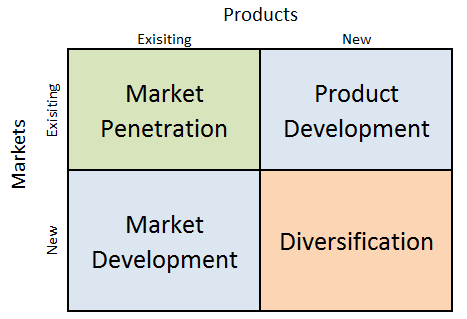
Amazon Ansoff Matrix is a marketing planning model that helps the e-commerce and cloud computing company to determine its product and market strategy. Ansoff Matrix illustrates four different strategy options available for businesses. These are market penetration, product development, market development and diversification. Amazon Ansoff Matrix Within the scope of Ansoff Matrix, Amazon uses all four growth strategies in an integrated manner: 1. Market penetration. Market penetration refers to selling existing products to existing markets. Amazon uses market penetration strategy aggressively. Sophisticated user experience features in general and recommendations feature on e-retailer’s website in particular play an important role in the application of market penetration strategy. Specifically, Amazon focuses on user experience personalization thanks to efficient application of data science and machine learning. The e-commerce giant collects and possesses a vast amount of data related to customers such as age, sex, lifestyle, habits and preferences. The company uses artificial intelligence (AI) to analyse this data and suggest products that a particular customer is highly likely to buy. 2. Product development. This involves developing new products to sell to existing markets. Product development is one of the core strategies used by Amazon. Started by Jeff Bezos selling only physical books online in 1997, today Amazon sells anything that can be sold online. The largest internet retailer in the world by revenue sells more than 500 million products, including products sold by third parties on Amazon platform. Top product categories include clothing, shoes, jewellery, home and kitchen appliances, books, electronic devices, sports and outdoor items and others. The e-commerce and cloud computing company produces increasing number of products under the private label as well. 3. Market development. Market development strategy is associated with finding new markets for existing products. Amazon is engaged in market development in a systematic manner. Started only in…

Square Ansoff Matrix is a marketing planning model that helps the B2B fintech to determine its product and market strategy. Ansoff Matrix illustrates four different strategy options available for businesses. These are market penetration, product development, market development and diversification. Square Ansoff Matrix Within the scope of Ansoff Matrix, Square uses all four growth strategies in an integrated manner: 1. Market penetration. Market penetration refers to selling existing products to existing markets. Square uses market penetration strategy extensively. Specifically, the payments company relies on viral marketing based on storytelling along with other marketing strategies to sell its financial products and services to small and medium businesses in North America, Canada, Japan, Australia, Republic of Ireland and the United Kingdom. Furthermore, the financial services and digital payments company offers individuals on the same locations listed above the services of storing, sending, receiving, spending and investing their money. 2. Product development. This involves developing new products to sell to existing markets. New product development is the main growth strategy for Square. Having entered the market only with a card reader, nowadays Square offers more than 30 distincg products and services for businesses and increasing numbers of products and services to individuals. . Each new product developed by Square further strengthens its expanding ecosystem of financial products and services. The financial services and mobile payments company is expected to further engage in product development strategy in an accelerated rate. 3. Market development. Market development strategy is associated with finding new markets for existing products. Square is cautious and overly selective in expanding in new markets. Moreover, there are entry barriers for the financial unicorn such as the level of financial infrastructure, regulatory barriers and the level of technological savvy for consumers. 4. Diversification. Diversification involves developing new products to sell to new markets…
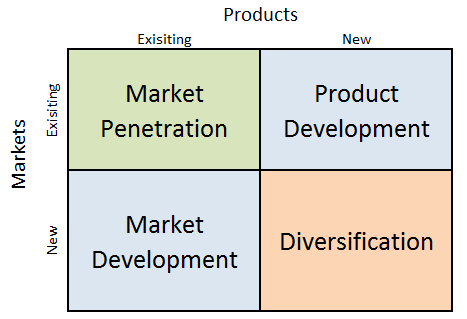
Uber Ansoff Matrix is a marketing planning model that helps the ride-hailing giant to determine its product and market strategy. Uber Ansoff Matrix illustrates four different strategy options available for the business. These are market penetration, product development, market development and diversification. Uber Ansoff Growth Matrix Within the scope of Ansoff Matrix, Uber uses all four growth strategies in an integrated manner: 1. Market penetration. Market penetration refers to selling existing products to existing markets. Uber engages in market penetration via application of various sales promotions techniques. These include distributing promo codes to allow users to have a discount for their next ride and “Uber VIP” loyalty program that rewards riders with special access to highest-rated drivers. Moreover, users can earn free rides by inviting their friends to sign up and ride with Uber. 2. Product development. This involves developing new products to sell to existing markets. The global transportation technology company consistently increases its service range. Currently, its extensive range of services include Uber X, Uber XI, Uber Pool, UberGO, Uber AUTO, Uber Access, Uber MOTO, Uber Premium and Uber Rush. Importantly, each new service introduced by the ride-hailing giant utilizes the same technological platform and competitive advantage of the business. 3. Market development. Market development strategy is associated with finding new markets for existing products. Launched only in San Francisco in 2009, the company currently operates in approximately 10000 cities worldwide. The global transportation technology company takes into account important aspects local culture when pursuing expansion strategy. The largest mobility platform in the world is expected to further engage in new market development business strategy. 4. Diversification. Diversification involves developing new products to sell to new markets. This is considered to be the riskiest strategy. Initially launched only as a taxi company, the ride-hailing giant has entered takeaway…
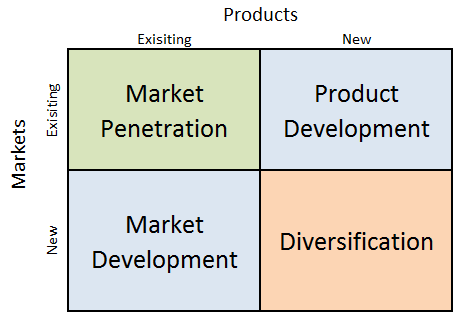
Tesla Ansoff Matrix is a marketing planning model that can be used by the alternative fuel vehicles manufacturer to make strategic decisions. According to Ansoff Matrix, there are four different strategy options available for businesses: market penetration, product development, market development and diversification. Tesla Ansoff Growth Matrix Within the scope of Ansoff Matrix, Tesla uses all four growth strategies in an integrated manner: 1. Market penetration. This strategy involves selling existing products to existing markets. Tesla uses market penetration strategy extensively. The company is focused on selling its Model S, Model X and Model 3 electric vehicles, Powerwall 2 and Powerpack 2 energy storage products, as well as, solar panels, inverters, racking, electrical hardware and monitoring devices in the US and 35 other countries[1]. 2. Product development. This strategy implies the development of new products to sell to existing markets. Tesla engages in new product development infrequently. This is mainly due to overly high cost of new product development in electric vehicles and power storage sectors. In Battery Day event in September 2020, CEO Elon Musk announced that the electric car maker had plans to enter into mining business. The company acquired the rights to a 10,000-acre plot in Nevada. In this site it plans to extract the metal using simple table salt, and would build a lithium refinery to supply a new factory in Texas. While the initial plan for Tesla is to use lithium for its own needs as raw material, the electric automaker can start selling this expensive material to others as well. 3. Market development. Market development strategy involves finding new markets for existing products. Tesla is evaluating a number of new markets to enter, India being in the shortlist. CEO Elon Musk “indicated it was the company’s Indian-born chief financial officer, Deepak Ahuja, who was…
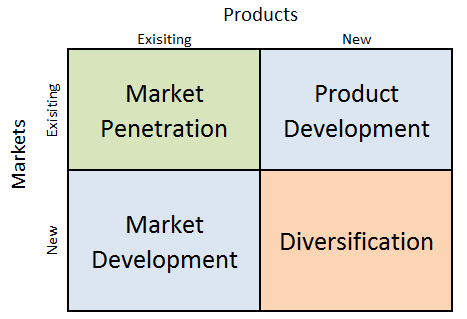
W.W. Grainger Ansoff Matrix is a marketing planning model that helps the global industrial supply company to determine its product and market strategy. Ansoff Matrix illustrates four different strategy options available for businesses. These are market penetration, product development, market development and diversification. W.W. Grainger Ansoff Matrix Within the scope of Ansoff Matrix, Grainger uses all growth strategies except diversification growth strategy in the following manner: 1. Market penetration. Market penetration involves selling existing products to existing markets. Grainger sells about 1,7 million types of MRO products covering a wide range of product categories.[1] The industrial supply company sustains market penetration business strategy via developing and maintaining relationships with customers through sales and service representatives and digital solutions. 2. Product development. This growth strategy is associated with developing new products to sell to existing markets. Grainger does not produce any product in-house, but continually expands its supplier base for new MRO products. Particularly, the worldwide distributor of industrial products is focused on expanding SKUs in its Zoro and MonotaRO subsidiaries to offset increasing competition from Amazon Business. In 2019 the company added about 1,5 million SKUs to its Zoro US assortment to increase it to approximately 3,5 million products.[2] 3. Market development. Market development strategy is associated with finding new markets for existing products. Currently, the B2B distributor has 456 branches and 30 distribution centres in US, Canada, Latin America, Japan and Europe. The worldwide distributor of industrial products may enter market in Asia in the foreseeable future[3]. Grainger enters new markets with Endless Assortment business model with a single online sales channel. Later, MRO products distributor may shift to High-Touch Solutions model in any given market if there is growing demand from large customers with more complex needs. 4. Diversification. Diversification involves developing new products to sell to new…
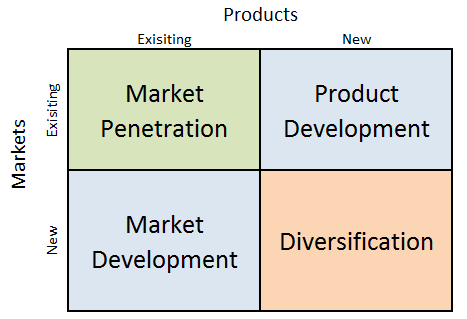
Airbnb Ansoff Matrix is a marketing planning model that helps the global hospitality service brokerage company to determine its product and market strategy. Ansoff Matrix illustrates four different strategy options available for companies. These consist of market penetration, product development, market development and diversification. Airbnb Ansoff Matrix Within the scope of Ansoff Matrix, Airbnb uses all four growth strategies in an integrated manner: 1. Market penetration. Market penetration involves the sales of existing products to existing markets. The accommodation and experience marketplace uses market penetration strategy extensively. Airbnb marketing strategy and exceptional customer services play instrumental role in engaging in market penetration by Airbnb. 2. Product development. This strategy is associated with developing new products to sell to existing markets. Product development is one of the main growth strategies for the global rental and experiences platform. Specifically, starting only as a short-term accommodation provider in 2008, Airbnb consequently increased its service portfolio to include experiences, adventures and restaurants services. 3. Market development. Market development strategy refers to finding new markets for existing products. The global rental and experiences platform aggressively engages in market development. Airbnb started its operations in San Francisco, California and today it has more than 6 million listings in more than 191 countries and regions worldwide.[1] Moreover, there are about 100000 cities with Airbnb listings.[2] 4. Diversification. Diversification can be explained as developing new products to sell to new markets. The global lodging company has engaged in diversification business strategy a number of times. Entering the industry as cost-effective accommodation provider for cost-conscious travellers, Airbnb has diversified the business to also serve premium market segment with respective offerings such as villas, mansions and even castles. Airbnb Inc. Report contains a full analysis of Airbnb Ansoff Matrix. The report illustrates the application of the major analytical strategic frameworks…
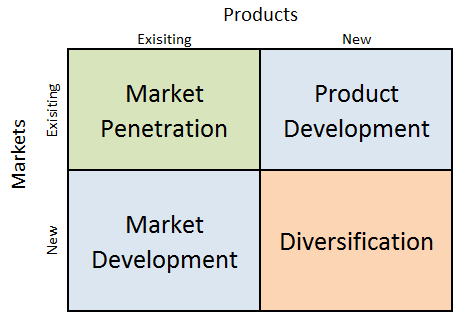
Microsoft Ansoff Matrix is a marketing planning model that helps the multinational technology company to select its product and market strategy. Ansoff Matrix distinguishes between four different strategy options available for businesses. These business growth strategies are market penetration, product development, market development and diversification. Microsoft Ansoff Matrix Microsoft uses all four strategy options within the scope of Ansoff Growth Matrix in an integrated way. 1. Market penetration. Market penetration refers to selling existing products to existing markets. Microsoft uses market penetration strategy to sell its Windows software and devices and other products in 116 Microsoft stores worldwide as well as through online channels and authorised distributors. The multinational technology company uses Microsoft Rewards loyalty program to pursue its market penetration strategy. 2. Product development. This growth strategy involves developing new products to sell to existing markets. Microsoft engages in product development strategy systematically. The tech giant’s research and development expenses increased USD 1.7 billion or 13% in 2018 compared to the previous year.[1] Microsoft develops most of its products and services internally through three engineering groups. Applications and Services Engineering Group, focuses on broad applications and services core technologies in productivity, communication, education, search, and other information categories. Cloud and Enterprise Engineering Group, focuses on our cloud infrastructure, server, database, CRM, enterprise resource planning, management, development tools, and other business process applications and services for enterprises. Windows and Devices Engineering Group, focuses on our Windows platform across devices of all types, hardware development of our devices, and associated online marketplaces. 3. Market development. Market development strategy is associated with finding new markets for existing products. Microsoft enters a new market whenever it sees there potential for its products and services. For example, HoloLens was made initially available only in 10 countries such as United States, United Kingdom, Canada, Australia…
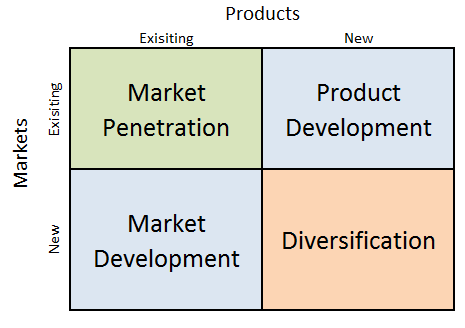
Xiaomi Ansoff Matrix is a marketing planning model that helps the mobile internet company to determine its product and market strategy. Ansoff Matrix illustrates four different strategy options available for businesses. These are market penetration, product development, market development and diversification. Xiaomi Ansoff Matrix Within the scope of Ansoff Matrix, Xiaomi uses all four growth strategies in an integrated manner: 1. Market penetration. When using market penetration, companies focus on selling existing products to existing customers. Xiaomi successfully uses market penetration strategy in its home market in China. According to Q1, 2018 smartphone sales results in China, Mi smartphones ranked third with the local market share of 12,8% after Huawei (20,8%), Oppo (18,5%), iPhone (18,2%) and Vivo (14,6%). 2. Product development. This strategy option involves developing new products to sell to existing markets. Xiaomi has ever-increasing product portfolio ranging from smartphones to water purifiers and tooth brushes. Product development strategy is likely to be continued by Xiaomi. This is because Xiaomi positions itself as a “company that provides innovation to everyone at every level — from smartphones and technology to IoT connected smart products to the basic everyday tools like power banks, backpacks and pens”.[1] 3. Market development. Market development strategy is associated with finding new markets for existing products. Xiaomi started market development in 2014, only four years after the company was founded. In mid-2013, the company hired Hugo Barra away from Google and Android to work on international expansion.[2] Since that time, the electronics and software company has established its presence in rapidly developing markets such as India, Singapore and Russia. The mobile internet company also has plans to enter US market.[3] 4. Diversification. Diversification involves developing new products to sell to new markets. Xiaomi is engaged in an aggressive diversification strategy. Xiaomi ecosystem is vast and comprises 55 companies,…
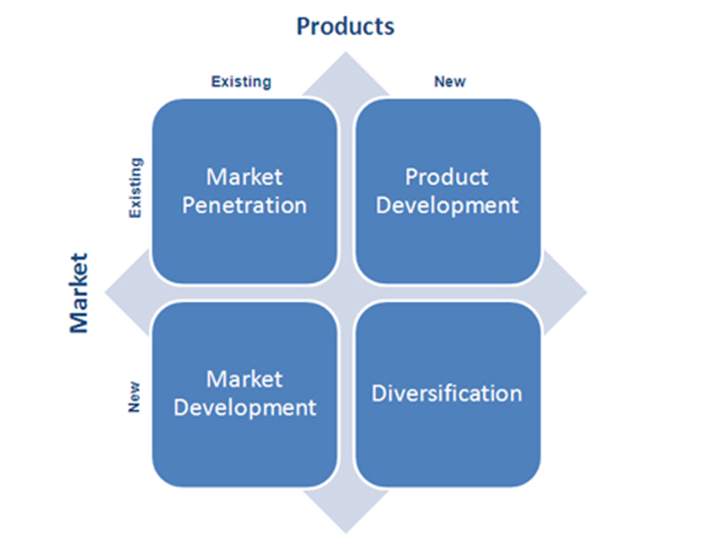
Ansoff Growth matrix assists businesses to increase their revenues by offering four different growth options depending on products and markets. According to the matrix market penetration is a type of growth where the company attempts to increase the level of sales of existing products into current markets. Product development growth strategy, on the other hand, involves introducing new products into current markets. A situation where a business enters new market with its existing products is marked as market development growth strategy. Diversification growth strategy can be achieved through offering new products into new markets. For example, this principle is followed by Warner Bros., although the extent of utilisation of each individual growth strategy varies. Warner Bros. uses market penetration and product development strategies in the US in particular through periodically introducing popular entertainment shows. Due to the following to this strategy for the season of 2012 – 2013, Warner Bros. Television has accounted for more than 30 per cent of top shows on broadcast TV in the US (Annual Report, 2013). Acquisition of 55 per cent of Shed Media plc, one of the leading entertainment firms in the UK for USD 100 million in 2010 (Annual Report, 2013) can be referred in order to illustrate market development strategy of Warner Bros. Diversification strategy, as discussed above is engaged by Warner Bros. in relation to quality of content and the manners of delivery and consumption of films and entertainment products and services. References Annual Report (2013) Time Warner
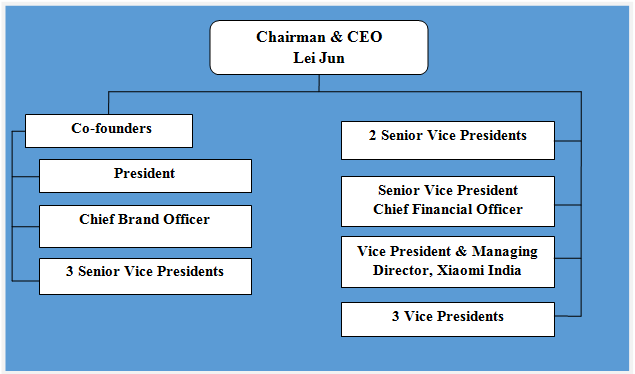
Xiaomi organizational structure can be classified as matrix. Specifically, Xiaomi organizational structure is decentralized, where different business units are managed independently. Despite the large size of the business involving presence in 70 countries with more than 18000 employees, the company has less layers of management compared to other businesses of similar sizes. Figure below illustrates Xiaomi organizational structure: Xiaomi organizational structure Matrix organizational structure allows the mobile internet company to develop its new products and services in a short duration of time. This is due to absence of bureaucracy that is associated with hierarchical organizational structures. However, disadvantages of matrix organizational structure for the business may include lack of strict control by the top management over separate business units and lack of integration between the operations of individual business units. Nevertheless, it is important for Xiaomi to maintain its flat organizational structure in order to remain flexible, so that the mobile internet company can adapt to frequent changes in the global marketplace. Xiaomi Inc. Report contains a full analysis of Xiaomi organizational structure. The report illustrates the application of the major analytical strategic frameworks in business studies such as SWOT, PESTEL, Porter’s Five Forces, Value Chain analysis, Ansoff Matrix and McKinsey 7S Model on Xiaomi. Moreover, the report contains analyses of Xiaomi leadership, business strategy and organizational culture. The report also comprises discussions of Xiaomi marketing strategy, ecosystem and addresses issues of corporate social responsibility.
